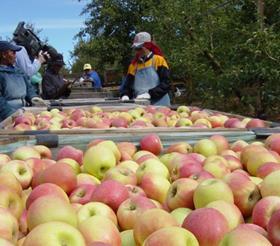
The South African topfruit industry has announced a steep reduction in the total export crop forecast for apples after weeks of intense heat that took a toll on crops in most of the country's production regions. The pear crop forecast, however, has dropped only marginally.
The apple export crop estimate is now just short of 23m cartons, which is 14 per cent, or 3.6m cartons, less than last year's crop. The pear export crop is expected to come in at 14.3m cartons, marginally lower than last year's 13.8m-carton result.
An industry statement said that the early and mid-season apple cultivars, such as the Gala group and Golden Delicious, have been badly hit by the heat. Gala volumes are forecast to be down 21 per cent compared with last year, and Golden Delicious volumes are expected to fall 20 per cent.
Current expectations for late season varieties are that Granny Smith volumes will be 15 per cent less than last year, with Pink Lady/Cripps' Pink and Sundowner/Cripps' Red expected to increase by 1 per cent on 2009.
This means that the 2010 export crop will be at the same level as 2007, following much better crops in 2008 and 2009.
Anton Rabe, Executive Director of Hortgro Services, said that the effect of the protracted cool spring and the recent heat wave has only just manifested itself. 'It appears that orchard culls are more severe than originally estimated, with sunburn being a major contributing factor which is reducing export packouts.'
Mr Rabe noted that although the total supplies are less than originally expected, export programmes in key markets should not be affected much.
He said that while Northern Hemisphere stock levels are up on the same time last year, it seemed that the tempo of stock reduction had been increasing. It is evident that although total world apple and pear supplies are in line with 2009, the tight market conditions may only apply to a few cultivars. 'Luckily these figures also confirm that the outlook for the unique RSA basket looks fairly favourable.'
There are now opportunities to capitalise on reduced supplies for most South African cultivars during the traditional Southern Hemisphere marketing season in order to mitigate the strong South African currency, which is putting severe pressure on producer payments, according to Mr Rabe.
The South African Rand has been trading below the R10.00 mark to the Euro this week, which means that growers are earning almost R3.00 per Euro less compared with the levels they could cover against last year's crop. Against the British Pound, the SA Rand is now trading just above R11.00 compared with over R14.00 in 2009.



